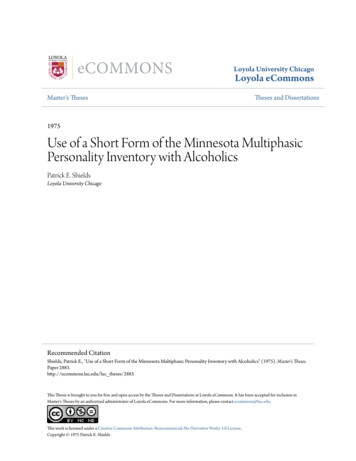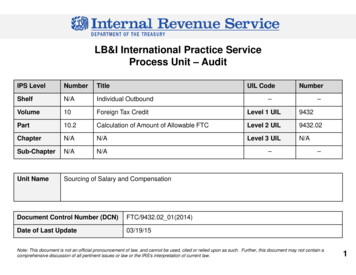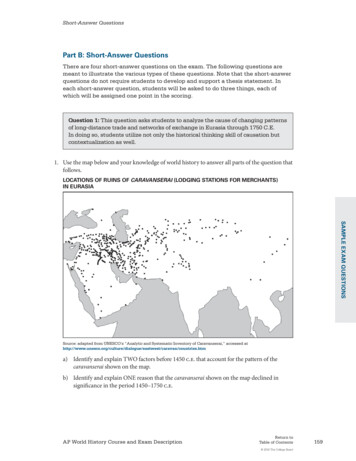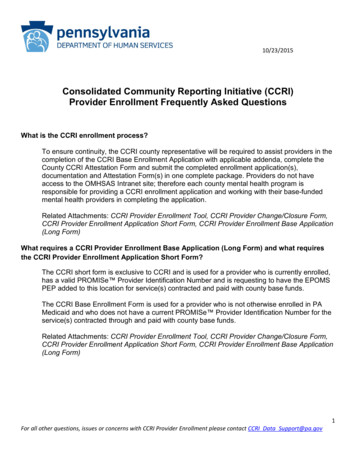
Transcription
Loyola University ChicagoLoyola eCommonsMaster's ThesesTheses and Dissertations1975Use of a Short Form of the Minnesota MultiphasicPersonality Inventory with AlcoholicsPatrick E. ShieldsLoyola University ChicagoRecommended CitationShields, Patrick E., "Use of a Short Form of the Minnesota Multiphasic Personality Inventory with Alcoholics" (1975). Master's Theses.Paper 2883.http://ecommons.luc.edu/luc theses/2883This Thesis is brought to you for free and open access by the Theses and Dissertations at Loyola eCommons. It has been accepted for inclusion inMaster's Theses by an authorized administrator of Loyola eCommons. For more information, please contact ecommons@luc.edu.This work is licensed under a Creative Commons Attribution-Noncommercial-No Derivative Works 3.0 License.Copyright 1975 Patrick E. Shields
USE OF A SHORT FORM OF THE MINNESOTAMULTIPHASIC PERSONALITY INVENTORYWITH ALCOHOLICSByPatrick E.ShieldsA Thesis Submitted to the Faculty of the Graduate Schoolof Loyola University of Chicago in Partial Fulfillmentof the Requirements for the Degree ofMaster of ArtsDecember1974
ACKNOWLEDGEMENTSThe assistance and interest of Dr. Frank J. Koblerand Dr. Roderick W. Pugh of Loyola University of Chicagois sincerely appreciated.The author is indebted to Miss Phyllis K. Snyder,Director of the Chicago Alcoholic Treatment Center,Mr.Julian Abraham, other staff members, and the patientsof the Chicago Alcoholic Treatment Center for their cooperation with the author throughout the research project.The author wishes to thank Dr. Frank Slaymaker,Mr.Ronald Szoc, and Dr.Stu rtMeshbaum for help withthe statistical analysis.Special thanks go to my wife, Deborah, for hersupport throughout the project.ii
LIFEPatrick E. Shields was born in Minneapolis, Minnesota on February 9, 1948.He graduated from Hill High School. St. Paul, Minnesota in May, 1966.He attended Nazareth Hall preparatoryseminary for two years and received the Associate of Artsdegree in 1968.He graduated magna cum laude from theCollege of St. Thomas in May, 1970.He is currently en-rolled in the Doctoral Program in Clinical Psychology atLoyola University of Chicago.iii
TABLE OF CONTENTSPageiiACKNOWLEDGEMENTS.iiiLIFE.viLIST OF TABLES.viiiCONTENTS OF APPENDICES.ChapterI.II.INTRODUCTION.1REVIEW OF RELATED LITERATURE.4Short Form Intelligence Test Research.Short Forms of the MMPI.Methodological Issues.Predicting Full Scale Scores fromShort Form Scores.Choice of Short Form Items Establishing Correspondence of Forms Practical ValiditySystematic Sources of Error.The Mini-Mult.III.METHOD.v.VI.RESULTS1315153435 37. . .DISCUSSION.SUMMARY78934Subjects Materials.Procedure.IV.456.3974 .76REFERENCES.78APPENDIX A.87APPENDIX B.89c.91APPENDIXiv
TABLE OF CONTENTS(CONTINUED)PageAPPENDIX D.93APPENDIX E.98APPENDIX.F.v100
LIST OF TABLESTable1.2.3.4.5.6.7.8.9.10.11.12.PageMeans and Standard Deviations Compared forMini-Mult and MMPI, Group 1.42Means and Standard Deviations Compared forMMPI1 and MMPI2, Group 3 43Means and Standard Deviations Compared forMMPil and MMPI2, Group 1 44Means and Standard Deviations Compared forMMPI 1 and MMPI , Group 2 .245Means and Standard Deviations Compared forMini-Mult and MMPI 2 , Group 2 47Means and Standard Deviations Compared forMMPI 1 and Mini-Mult, Group 2 48Means and Standard Deviations Compared forMMPIand Mini-Mult, Group 3 249Means and Standard Deviations Compared forMMPI 1 and Mini-Mult, Group 3 50Means and Standard Deviations Compared forMini-Mult and MMPr 2 , Group 2 52Means and Standard Deviations Compared forMini-Mult, Group 1, and MMPI 1 , Group 2 53Means and Standard Deviations Compared forMMPI 1 , Group 2 and MMPI , Group 3.154Means and Standard Deviations Compared forMini-Mult, Group 1 and MMPI , Group 3.113.14.55Means and Standard Deviations Compared forMMPI 2 , Group 1 and MMPI , Group 2.257Correlations Compared for MMPI 2 - Mini-Mult,Group 3 and Mini-Mult - MMPI 1 , Group 158vi
LIST OF ageCorrelations Compared for Mini-Mult MMPI ,2Group 2 and Mini-Mult - MMPI , Group 1.159Correlations Compared for MMPI- Mini-Mult,2Group 3 and MMPI 1 - Mini-Mult, Group 2. .61Correlations Compared for MMPI- MMPI ,12Group 1 and MMPil - MMPI2, Group 3.62External Correlations Reported in FiveStudies .64Profile Highpoint Agreement for MMPI 1 - MMPI ,2Group 1, and MMPI 2 - Mini-Mult - MMPI 1 , Group 167Profile Highpoint Agreement for MMPI- MMPI ,12Group 3 and Mini-Mult - MMPI , Group 1.168Profile Highpoint Agreement for MMPI- Mini2Mult, Group 3 and Mini-Mult - MMPI , Group 1.169Correspondence Between MMPI , Group 1 and1Mini-Mult Contained Within ItMini-Mult Test - RetestC mparisonsvii 7172
pCONTENTS OF APPENDICESAppendixPage.A.MMPI 2 and Mini-Mult Mean Scores, Group 3B.Mini-Mult and MMPI 1 Mean Scores, Group 1c.Volunteer Information Sheet.91D.Mini-Mult.93E.Kincannon's Conversion Table for the8789Prediction of Standard Scale Raw ScoresFrom the Mini-Mult Raw Scores.F.Internal Comparisons .viii98.100
CHAPTER IINTRODUCTIONThe value of diagnostic testing has been questionedby a number of people in recent years.Rosenwaldobserves a trend to deprecate the role of testing.(1963)Somehave suggested disposing of testing because i t is a productof the medical model and fosters the "illness" conceptionof emotional problems(Szasz, 1961).Another criticismstems from the fact that the amount of knowledge gainedfrom testing is not justified by the expense in terms ofmoney and valuable professional time necessary for a thorough diagnostic evaluation, or is not relevant to treatment(Hunt, 1971, p.7).One remedy for the cost-benefit imbalance has beento reduce the amount of time necessary for diagnostic evaluation by reducing the length of standard instruments.This reduction in testing time seems to be the main motivator behind the development of short-form(SF)tests.some reports, this aim must be considered obvious,statement of purpose of the SF is givenfor no(Levy, 1968).Other reasons for an SF are given by Kincannon(1968).In clinical situations, patients are frequentlyunable or unwilling to complete either the individual or1In
2the group form of the MMPI.These same patients, however,usually agree to answer a short series of orally administered questions.Consultation situations call for rapidThe length of the MMPI makes its use in re-evaluation.search time-consuming and bothersome to respondents.AnSF test could be included in mailed questionnaires and inmultivariate projects without causing high S attrition andexpense.The present study will attempt to assess the usefulness of a short form of the MMPI with alcoholics at theChicago Alcoholic Treatment Center(CATC).The MMPI isused with alcoholics in many treatment settings to screenfor individuals whose emotional problems are of such amagnitude that they are not available for treatment.Ashort form MMPI could serve tfiis same function, but at asavings in money, and staff and patient time.The purpose of the present study is:1.To provide a comparison between MMPI and Mini-Mult scores to determine if the Mini-Mult is suitable foruse at CATC.This determination is to be based on statis-tical tests and also profile similarity.2.To provide a comparison between the agreementof the MMPI with the external Mini-Mult and the agreementof the MMPI with a retest of the MMPI.This comparisonis necessary since the former would not be expected toexceed the latter.The MMPI scores are influenced to a
3small degree by random or day to day fluctuation and thusthe discrepancy between the Mini-Mult and the MMPI is duein part to error variance in the MMPI score.3.To test the hypothesis that higher correlationswill be obtained between forms administered on days 2 and3 than between forms administered on days 1 and 2.Thesocial desirability factor which has been shown to createscore differences between days 1 and 2 is hypothesized tor ducecorrelations between days 1 and 2, but to have l i t -tle effect on correlations between days 2 and 3.4.To provide an estimate of the stability of theMini-Mult over a period of approximately three weeks.
CHAPTER IIREVIEW OF THE LITERATUREShort Form Intelligence Test ResearchA great deal of research has been done on SFs ofstandard intelligence tests, beginning with Doll's(1917)questioning of the need to use all the Binet-Simon itemsfor the clinical assessment of intelligence.Althoughthis study is primarily concerned with research on SFsof the MMPI,issues in SF intelligence testing are dis-cussed when relevant.Many of these issues will be dis-cussed in the section on methodological problems.Anissue not necessarily related to methodology is that ofstandards for SF acceptance.No clear-cut standards can be found that serve asa basis for accepting or rejecting an SF.said,Doppelt(1956)"A compromise must be made between economy of timeand effort and accuracy of prediction"(p. 63).Levy(1968) has proposed what he calls a "decision-theoreticframework."According to Levy,If we are to judge how much validity may be sacrificed,an equation must be found which defines a utility orcost function for the relationship between validitylost and time saved; otherwise no solution is possible.4
5No amount of conventional statistical manipulation ofdata, however sophisticated, can develop such a solution.It is clear that standards of acceptability for SFsare somewhat arbitrary.Some idea of what standards havebeen adopted can be gained from looking at which SFs havebecome popular and which have not.Short Forms of the MMPIAn early short form of the MMPI called the HastingsShort Form (Olson, 1954) was designed to save 26% of testing time.The inventory was limited to the first 420 itemsof the MMPI.The only items beyond this point scored onthe clinical scales are items on scale O (Si).lidity scale also has twoite sThe K va-beyond this point.Otheritems beyond this point are research items to be used forconstructing new scales.The scores for scales 0 and Kwere derived by constructing a table of proration basedon a comparison of scores obtained on items preceding andfollowing item 420.The prorated scores correspondedclosely to long form scores."Olson's procedure did notattract a great deal of interest, probably because theproration procedure did not add enough significant clinical information to warrant clinicians changing theirtesting instructions and computations.A more direct, and slightly shorter method of obtaining standard MMPI scores was introduced by Hathaway
/I6and McKinley {1967).This method was called Form R of theMMPI, and was published and used widely.It consisted ofthe standard MMPI items, but re-arranged so that the research items{items not scored on any of the validity orclinical scales) were put at the end of the inventory.This arrangement permits responses to all standard scorable items with a reduction of test length to 399 items.Holzberg and Alessi{1949) had removed unscoreditems from the card form of the MMPI and saved one thirdof the testing time.Although they found statisticallysignificant differences between test and retest scoresfor half of the scales, their profiles were not significantly different {according to their clinical judgement)and their test-retest rs compared favorably to reliabilitydata reported in the literatu Several early attempts to predict MMPI standardscores from SFs{Jorgenson, 1958; Foulds, 1960) were un-successful.Altus and Bell{1947) and Clark {1948)reported onbrief oral adjustment scales adapted from the MMPI.Thecorrespondence of these brief instruments to the MMPI wasminimal{Dahlstrom, Welsch, & Dahlstrom, 1971).Methodological IssuesA number of methodological problems are responsiblefor the difficulties encountered in developing SF inventories and tests.Kincannon(1968)raises the possibility
p7that a conviction or assumption on the part of researchersthat methodological problems are unavoidable may have beena deterrent to SF construction in the past.There is a"general assumption that a longer test is significantlymore reliable and therefore potentially more valid thana shorter one"(Kincannon, 1968).A fear of the predic-tions of the Spearman-Brown formula has discouraged testing its predictions.But Kincannon argues that the assump-tions underlying this formula may render it inappropriatefor use with a systematic reduction in length of the MMPI.One assumption of the Spearman-Brown formula is thatall items in a scale are equivalent.Kincannon cites ampleevidence that the MMPI scales are quite heterogeneous.Thesecond assumption is that item deletion would be made on arandom basis.But sincepredi tionof a rue"MMPI scoreis the goal, a systematic deletion, retaining the most representative items, would be more advantageous.Since theassumptions underlying use of the Spearman-Brown formulaare, or can be rendered inapplicable for the MMPI, Kincannon suggests that the attenuation of the validity of anSF of this instrument be tested empirically.Predicting Full Scale Scores from Short Form ScoresDeveloping an SF necessitates stipulating a procedure by which to assign an estimated standard score to theobtained SF score.Briggs and Telegen(1967)describe howboth the mean and standard deviation of the SF can be
adjusted by use of a regression equation of the formax b, where X is the raw score of the SF, a is a constant equating the standard deviations, and b is a constant equating the means.Briggs and Telegen point outthat this method is an improvement over the method usedby Olson(1954)as inadequate.whose SF MMPI has been described aboveOlson set b 0 and adjusted a.Thisprocedure does not adjust both the mean and standarddeviation.Choice of Short Form ItemsAs mentioned earlier in connection with the assumptions of the Spearman-Brown formula,items of the MMPIare not deleted from the FS on a random basis in orderto obtain the SF.An attempt smade to retain the mostrepresentative items, i.e. those most highly correlatedwith the score obtained on the scales of the FS.Themethod that has been used to accomplish this is a selection of items for each scale based on a factor analysisof that particular scale(Kincannon, 1968).This appearsto be the best method currently available for selectingitems.However, certain features of the MMPI raise ques-tions about this item selection procedure.The MMPIscales are not factorially "pure" or independent.erable correlation exists between scales.Consid-This is compli-cated by the fact that some items are scored on more thanone scale.It is possible that profile configurations are
9a product of this item redundancy {Shure and Rogers, 1965).Knowledge of the factor structure of the entire MMPImight make prediction more accurate.However, the largenumber of items makes a complete factor analysis nearlyimpossible by present methods.Stein {1968) has describedexperimenting with a method whereby the factor structureof the MMPI may be estimated by a sampling technique.Ifthis method is perfected i t might provide a set of SFitems which predicts FS scores more accurately than theSFs developed by present methods.However, using itemsnot scored on a particular scale to predict that scaleraises questions about interpretation, meaning and evenname of the scale.It is also possible, as Kincannon(1968) pointsout, that the factor analytic model is not the best modelfor constructs tapped by the MMPI.In Kincannon's words,"The scores seem to reflect the functioning of aggregatesof statistically disjunctive indicators of a constructrather than variations along certain sets of homogeneousdimensions."Establishing Correspondence of FormsAs mentioned previously, a good deal of work hasbeen done on short forms of intelligence tests.Whileresults have been reported that appear promising, Luszki(1970) points out that losses in reliability have beenobscured by looking at only part-whole correlations.
10Citing research on SFs of the WAIS, he states that thefindings are consistent with the Spearman-Brown formulain that less reliable tests show a more drastic loss inreliability.This conclusion does not necessarily suggest thatitem deletion on the MMPI will leave i t with inadequatereliability.Item-scale correlations differ for the twoinstruments.And in view of Kincannon's points aboutfaulty assumptions,it would be wise to let the dataspeak for itself.But this raises the problem of what data to "letspeak."A demonstration of the reliability and validityof an SF is the desired outcome.The traditional statis-tic used to achieve such a demonstration is the correlation coefficient.Levy(1968)has taken exception to theuse of the SF-FS correlation coefficient for evaluatingthe SF in special diagnostic groups.He notes that thecorrelation coefficient is lowered by homogeneity on oneor both of the variables.He suggests that "the regres-sion slope of the FS scores on SF scores provides a moreappropriate test of whether or not an SF.developed on awide range sample remains satisfactory for more restrictedgroups such as the mentally retarded or high school students."This is an important consideration since one ofthe recommendations that has been made in MMPI SF researchis that the SF be validated on each new population with
11which it is used(Armentrout and Rouzer, 1970).A compar-ison should be made between the homogeneity of the groupwith which the SF was developed and the new group it isto be used with.Levy mentions another problem that might producecorrelations that are too high rather than too low.Thisproblem stems from the fact that the SF is included in theFS and thus the correlation between the two is spuriouslyhigh.He quotes Doppelt(1956), who argued that the spur-ious nature of the coefficients did not matter because theSF replaces itself.termediate position:Levy quotes himself as taking an in"The spurious nature of the SF-FScorrelation is not due to the inclusLon of the part scorein the whole as such, but is due to the inclusion of theerror variance of the part score in both scores."Levy does not offer a method of correcting for thisdifficulty, but warns that SFs differing in reliabilityare not comparable because their validities are spuriouslyhigh to different degrees.This point should be kept inmind when deciding which of several SFs is the best instrument.Another point made by Levy, and one that is relevant to the above discussion of standards of acceptanceof SFs, is that the FS should not be the absolute criterion to be predicted if SF and FS are administered independently(the external SF, as opposed to the internal SF
12which is obtained by scoring the SF from the FS protocol).If prediction of the "true" score is the goal, and the FSis not perfectly reliable, then the SF need notnot)correlate perfectly with the FS score.(and canFrom this itfollows that the appropriate comparison is between theSF-FS correlation coefficient and a standard test-retestreliability coefficient.If the SF is not administered independently,thatis, the SF score is obtained by scoring the original FS,the need for a test-retest control is removed unlesscontextual effects create a difference.Kincannon minimized the role of contextual effects,thus opening the door for doing research on SFs withscores extracted from the standard MMPI.This makesresearch easier, but it may be somewhat premature.Kin-cannon based his assertion of the absence of this kindof contextual effect on a study by Perkin and Goldberg(1964).This study does show an absence of statisticallysignificant difference between sets of MMPI items arrangedin different order.But it does not compare sets of itemsof different lengths, except by inferring that responsesto items first in a list are identical to responses toitems in a shorter list.This may not be the case,sincesubjects may approach the two lists with different expectations and/or level of motivation.cite a study by Gordon(1952)Perkin and Goldbergshowing that subjects tend
13to respond to items in a more socially desirable fashionas they reach the end of a long inventory.Also, Perkinand Goldberg provide no evidence that practical decisionsbased on the responses made to items of altered order areequivalent.Newton(1971)saw the need to compare internal toexternal SFs, but his comparison was inappropriate becausehe did not use a retest MMPI as a control.from the points made by Levy above,As can be seenthe internal SF shareserror variance with the original FS that the external SFdoes not.Comparing the external SF to the original FSattributes all the unshared error variance to the SF.alternate method was used by Holzberg and AlesiAn(1949).They simply compared the SF-FS correlations to reliabilitycoefficients reported by other researchers.Practical ValidityFrom the above discussion it can be seen that thecorrelation coefficients obtained in SF research may beinflated, deflated, or inappropriately applied.But evenif confidence can be put in the interpretation of the correlation coefficient, and even if this coefficient is veryhigh,the usefulness of the SF may still be suspect.Mumpower(1964)has shown that misclassifications canoccur when SF scores are used to put subjects into categories, even when SF-FS correlation coefficient is .95.The coefficient seems quite high, but Mumpower illustrates
14that statistics can be misleading.He points out thatwith a correlation of .90, only 81% of the variance inthe SF test scores is attributable to the FS score.Thisleaves nearly one fifth of the variance unaccounted for.Kramer and Francis(1965)also report greater than expect-ed errors in classification associated with a correlationcoefficient that is very high.,,---This problem has been recognized by researchersworking with MMPI SFs, and the various measures of practical validity they have employed will be discussed belowin the section dealing with this research.Practical validity is not determined completely bythe usual statistical tests, nor by hard-and-fast standardsof psychometric tradition, but is based in part on the demands of a particular clinic and the clients' motivations.The need to assess practical validity is illustratedby Lichtenstein and Bryan(1966).They have rank-orderedscale scores of the MMPI for two administrations and found"little evidence of profile stability" for individual proThey report that small shifts in scale score canfiles.result in large changes in profile, if profile is definedas rank order of the scales."The profile stability overgroups appears to be quite adequate for research use butthere is risk of misclassifying individual profiles whenclinicalRosen(or actuarial)(1966)interpretations are to be made."also urges that statistical significance not
15\be confused with "clinical or practical significance."Systematic Sources of ErrorDifferences between test scores on two differentoccasions, using the same test or an SF and FS, may bedue to random error, or to systematic factors.One sourceof systematic error that may influence scores is the tendency for sto respond in a more socially desirable wayon the second administration(Kincannon, 1968; Newton,1971) .Howard(1964)and Howard and Diesenhausdemonstrated another systematic factor.(1965)haveThey have shownthat responses tend to become more stable and yield agreater differentiation of individuals on later administrations of tests.Item variances increased on later ad-ministrations, and more reliable individual differenceswere found.It is evident that order of testing and number ofretests are factors that might influence correlation coefficients.The Mini-MultKincannon(1968, 1967), who has been cited manytimes in the section on methodology,seemed to succeed inproducing an SF MMPI in spite of methodological problemsthat had previously appeared insurmountable.His discus-sion about the inapplicability of the Spearman-Brown
16formula and justification of the MMPI's poor fit with thefactor-analytic model have been discussed above.Kincannon chose 71 items from the MMPI by pickingitems from Comrey's(1957a, 1957b, 1957c, 1958a, 1958b,1958c, 1958d, 1958e, 1958f; Comrey and Margraf , 1958)clusters that are scored on the greatest number of clinical and validity scales.Mult.This SF was called the Mini-Comparisons were made between MMPI and internalMini-Mult scores for an inpatient and an outpatient grouprecently admitted to the psychiatric service of a citycounty general hospital.Regression equations were de-veloped from these two samples in order to predict standard scores from Mini-Mult scores.A third group, con-sisting of inpatients recently admitted to the psychiatricservice of the same general h ipital, was given astandardadministration of the MMPI, and then a retest of the MMPIand an orally administered Mini-Mult, the latter two beingalternated between the sedond and third position in thesequence.Following the suggestions made by authors citedabove in the section on methodology, Kincannon comparedthe Mini-Mult's ability to predict the standard scoreswith a retest's ability to do the samescores contain error).Also,(since the originalin addition to the correla-tional data, Kincannon used methods aimed at assessing theMini-Mult's practical significance.This included:
17(1)a comparison of the Mini-Mult and the retest withrespect to the ordinal position of the three clinicalscales highest in rank on the original administrationof the MMPI,and(2)a rating by experienced cliniciansof the percentage of overlap between profiles based onthe original MMPI and profiles based on the retest orthe Mini-Mult(in alternate order).In comparison with a readministration of the standard form,the Mini-Mult was found to suffer only aloss estimated by the clinicians'14%ratings of profileoverlap.Kincannon points out several weaknesses of theMini-Mult.The F scale does notpre ictextremes well.The fact that error is introduced by use of the Mini-Multwould argue against its use w never a standard formcould be administered.But in spite of the error intro-duced, Kincannon sees a use for the Mini-Mult:"When noother comparable psychometric testing is available, however, i t seems likely that the amount of error introducedthrough use of the Mini-Mult would be tolerable."An important point brought up earlier is the factthat the homogeneity of the group tested influences thecorrelation coefficient between SF and FS scores.Thisfact must be kept in mind when comparing results of investigators who have extended Kincannon's research.Attention must be paid to subjects'age, education,IQ,
18socio-economic status, and psychiatric diagnosis and othervariables which might systematically influence variabilityin obtained scores.Age,search.in particular, should be reported in this re-Gynther and Shimkunas{1966) have shown that Tscores on scales 4, 6, 8, and 9 are affected by age.Theyalso report that scores on scales L and F are affected byintelligence, and scores on F are affected by both age andintelligence.Scores on scale 2 are not affected by age,but older patients more often have profile peaks on scale2 because of decreases in T scores on the other scales.Davis{1972) reports that the MMPI has more "power" todiscriminate schizophrenics from nonschizophrenics withyoung patients{18 to 28 years)than with older patients{45 to 56 years).Lacks{1970)reports a"high degree of accuracy"of prediction with the Mini-Mult.wide range in age{17-63)His sample covers ayears), education {3-16 years),and IQ {WAIS FSIQ 66-131).Using correlations based on an internal Mini-Mult,Lacks reports correlations ranging from .68 to .89, witha median of .83.This agrees with Kincannon's mediansfor this type of comparison {both were .87).A signif-icant difference was found between the MMPI and Mini-Multon scales F and Ma, and Lacks warned that these two scaleson the Mini-Mult tend to underestimate the MMPI.
19Lacks used the three clinical code types of Haertzenand Hill(1959)as one measure of practical validity.of these types consists of peaks on scales 1, 2,One3, or 7;the second type, peaks on 6 or 8; and the third, peaks on4 or 9.No significant difference was found between theMMPI and the Mini-Mult compared in this fashion.Anothermeasure of practical validity reported by Lacks is labelledIndexes of Psychopathology.defined:(2)(1)Five classes or indices areone or more clinical scales greater than 69;three or more clinical scales greater than 69;five or more clinical scales greater than 69;above 11 raw score points;points.(4)(3)F scale(5) F scale above 15 raw scoreAgreement between MMPI and Mini-Mult on these in-dices ranged from 91% to 100%, with the median 96%.Therewas 65 to 92%, with a median of 87%, agreement on predicting absence of maladjustment.Lacks concluded by suggesting that a better designwould be to test the correspondence of the external MiniMult to the MMPI.As stated earlier, it has not beenshown that the internal comparison is equivalent to anexternal comparison, and a retest control should be usedfor an external comparison.Lacks and Powell(1970)report that "the Mini-Multis reliably and highly related to the standard MMPI" fora population of psychiatric attendant applicants.However,there are a number of shortcomings in this study.An(
20internal comparison was used, limiting conclusions aboutcorrespondence in real-life administrations of the MiniMult.Only T tests are reported;validity are included.no indices of practicalAlso, a predominantly Black sam-ple was used, and Gynther(1972)has suggested that theMMPI interpreted in the usual way might be used to thedisadvantage of Black job applicants.Armentrout and Rouzer(1970)reported a less sat-isfactory correspondence of MMPI and Mini-Mult with juvenile delinquents.While the group data showed good corre-spondence, many individual profiles were misclassifiedaccording to validity, high points, and number of scalesabove 70 T score points(practical validity indicators).This lack of correspondence could be due to several fac.tors.Armentrout an
An early short form of the MMPI called the Hastings Short Form (Olson, 1954) was designed to save 26% of test-ing time. The inventory was limited to the first 420 items of the MMPI. The only items beyond this point sco










